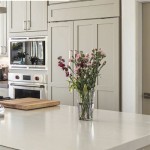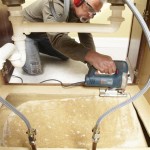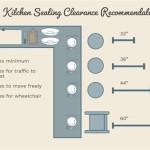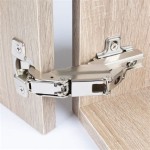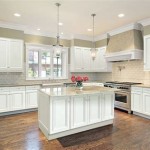Overlay Kitchen Cabinets: A Comprehensive Guide
Overlay kitchen cabinets are a popular design choice, known for their sleek appearance and relatively straightforward installation. Understanding the nuances of overlay cabinets, including their different types, installation considerations, and aesthetic impact, is crucial for homeowners and kitchen designers aiming to create a functional and visually appealing space.
Essentially, overlay cabinets are defined by how the cabinet doors and drawer fronts relate to the cabinet frame or face frame. In contrast to inset cabinets, where the doors and drawers sit flush with the frame, overlay cabinets have doors and drawers that partially or completely cover the frame. This design difference significantly impacts the overall look and feel of the kitchen, influencing everything from the style to the perceived spaciousness.
The term "overlay" refers to the degree to which the door and drawer fronts cover the cabinet frame. Understanding this difference is essential for choosing the right type of cabinet and hardware to achieve the desired aesthetic.
Types of Overlay Cabinets
Overlay cabinets can be broadly categorized into two main types: partial overlay and full overlay. Each type offers a distinct look and varies in terms of cost and installation complexity.
Partial Overlay Cabinets: These cabinets, sometimes called standard overlay, feature doors and drawer fronts that only partially cover the cabinet frame. Typically, a portion of the frame, usually around one to two inches, remains visible around the doors and drawers. This creates a traditional or transitional aesthetic, often associated with a more budget-friendly option due to the simpler construction and reduced material requirements.
Partial overlay cabinets tend to have a more forgiving installation process. The visible frame provides some leeway for minor alignment imperfections. Furthermore, the gaps between the doors and drawers, and the visible frame, contribute to a more forgiving environment in terms of expansion and contraction due to humidity changes. This can be particularly beneficial in climates with significant seasonal variations.
Full Overlay Cabinets: Full overlay cabinets, as the name suggests, feature doors and drawer fronts that completely or almost completely cover the cabinet frame. A very small margin, typically only a fraction of an inch, may be visible. This creates a seamless, modern, and streamlined appearance. The minimal frame exposure results in a clean and contemporary aesthetic, often preferred in modern or minimalist kitchen designs.
The installation of full overlay cabinets requires greater precision and attention to detail. Because the doors and drawers are so close together, even slight misalignment issues can become readily apparent. The minimal gaps between the doors and drawers also mean that expansion and contraction of the wood due to humidity changes can be more problematic, potentially leading to rubbing or sticking. Consequently, high-quality materials and professional installation are often recommended for full overlay cabinets to ensure long-term performance and aesthetic appeal.
Beyond these two primary types, there are variations in the overlay style. Some manufacturers offer "modified" overlay cabinets, which fall somewhere between partial and full overlay. These offer a balance between the traditional look of partial overlay and the modern feel of full overlay. These variations often aim to provide a specific aesthetic or address unique design constraints within a kitchen space.
Installation Considerations for Overlay Cabinets
The installation of overlay cabinets, regardless of the type, requires a methodical approach and careful attention to detail. Proper installation is crucial for ensuring the longevity and functionality of the cabinets.
Leveling and Alignment: The first and perhaps most critical step is to ensure that the cabinets are perfectly level and plumb. Any deviation from level can lead to issues with door and drawer alignment, potentially causing them to bind, rub, or not close properly. Shims are typically used to make fine adjustments to the cabinet boxes before they are secured to the wall. Using a high-quality level and plumb bob is essential for achieving accurate results.
Hardware Selection: The choice of hinges and drawer slides is crucial for overlay cabinets. Concealed hinges are commonly used, especially for full overlay cabinets, as they contribute to the clean and streamlined appearance. These hinges allow for precise adjustments, enabling installers to fine-tune the alignment of the doors. Drawer slides should be of high quality and capable of supporting the weight of the drawers when fully extended. Soft-close mechanisms are a popular upgrade, providing a smooth and quiet closing action.
Reveal Management: "Reveal" refers to the amount of cabinet frame that is visible around the doors and drawers. While full overlay cabinets aim for minimal reveal, partial overlay cabinets intentionally showcase a portion of the frame. Maintaining consistent reveals is essential for a professional and visually appealing installation. This requires careful measurement and precise placement of the doors and drawers. Using spacers or jigs can help ensure consistent reveals throughout the kitchen.
Door and Drawer Adjustments: After installation, the doors and drawers may require further adjustment to ensure proper alignment and smooth operation. Most concealed hinges offer three-way adjustability, allowing for adjustments in height, depth, and side-to-side movement. Drawer slides typically have limited adjustment capabilities, but it's important to verify that the alignment is correct and that the drawers slide smoothly. This final adjustment process is crucial for achieving optimal functionality and aesthetics.
Wall Conditions: Pre-existing wall conditions can significantly impact the installation process. Uneven walls or walls that are not perfectly plumb can create challenges in achieving a flush and seamless cabinet installation. In such cases, it may be necessary to build out the wall or use shims to compensate for the irregularities. Accurate measurements and careful planning are essential for addressing these challenges.
The choice of fasteners is also important. Screws used to attach the cabinets to the wall should be long enough to penetrate into the wall studs, providing a secure and stable connection. Using the appropriate type of screw for the wall construction is also essential. For example, drywall screws should not be used to secure cabinets to solid wood studs.
Aesthetic Impact and Design Considerations
Overlay cabinets significantly impact the overall aesthetic of a kitchen. The choice between partial and full overlay influences the style and perceived spaciousness of the room.
Style and Aesthetic: Partial overlay cabinets generally lend themselves to traditional or transitional kitchen designs. The visible frame adds a layer of detail and visual interest, creating a warmer and more familiar feel. Full overlay cabinets, on the other hand, are typically associated with modern or contemporary designs. The seamless appearance and clean lines contribute to a sleek and minimalist aesthetic.
Space Perception: Full overlay cabinets can create the illusion of greater space, particularly in smaller kitchens. The minimal frame exposure makes the cabinets appear to blend together, creating a more streamlined and less cluttered look. This can be especially beneficial in kitchens where maximizing space is a priority. Partial overlay cabinets, with their visible frames, can define the individual cabinets more distinctly, which may be desirable in larger kitchens or those with a more traditional style.
Hardware Choices: The choice of hardware, such as knobs and pulls, can further enhance the aesthetic impact of overlay cabinets. For partial overlay cabinets, bolder and more decorative hardware can complement the traditional style. For full overlay cabinets, sleek and minimalist hardware options are often preferred to maintain the clean and contemporary look. Consider the finish and style of the hardware in relation to the cabinet doors, drawer fronts, and overall kitchen design.
Door Styles: The style of the cabinet doors themselves also plays a significant role in determining the overall aesthetic. Shaker doors, with their simple and clean lines, are a popular choice for both partial and full overlay cabinets. Raised panel doors are more commonly associated with traditional kitchens and often paired with partial overlay cabinets. Slab doors, with their flat and unadorned surface, are typically used in modern kitchens with full overlay cabinets.
Color and Finish: The color and finish of the cabinets can further accentuate the desired aesthetic. Light and neutral colors can make a kitchen feel brighter and more spacious, while darker colors can create a more dramatic and sophisticated look. The finish, whether it's a painted finish, a stained finish, or a laminate finish, can also impact the overall feel of the kitchen. High-gloss finishes are often used in modern kitchens, while matte finishes are more common in traditional kitchens.
Integrated Appliances: Full overlay cabinets are particularly well-suited for integrating appliances into the kitchen design. By using custom panels that match the cabinet doors, appliances such as refrigerators and dishwashers can be seamlessly integrated into the cabinetry, creating a cohesive and unified look.
By considering these aesthetic factors, homeowners and designers can create kitchens that are not only functional but also visually appealing and reflective of their personal style.

What Is Cabinet Overlay Showplace Cabinetry

Inset Vs Overlay Cabinets What S The Difference

Cabinet Types Inset Cabinetry Vs Overlay

Cabinetry 101 Understanding Overlay Cabinet Doors Dura Supreme

White Shaker Full Overlay Inset Kitchen Remodel Transitional Other By National Woodwork Houzz Ie

34 Full Overlay Cabinets For Your Next Home Renovation

Face Framed Cabinets How To Increase Overlay Nieu
Kitchen Cabinet Doors Full Overlay Partial And Inset Degnan Design Build Remodel

Cabinetry 101 Understanding Overlay Cabinet Doors Dura Supreme Kitchen Remodel Bar Design Shaker Cabinets

Kitchen Cabinet Styles Inset Full Overlay And Standard Aco
Related Posts

